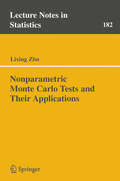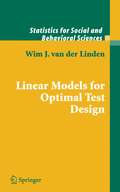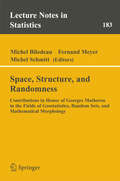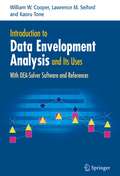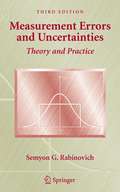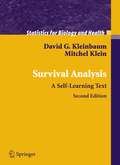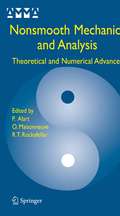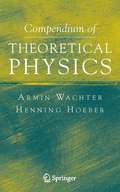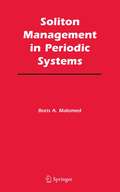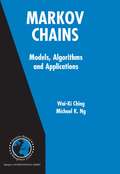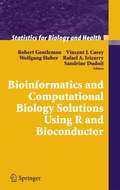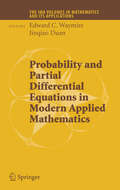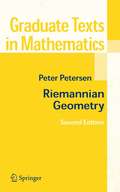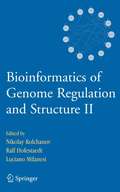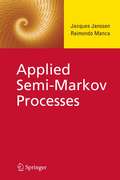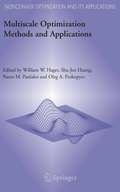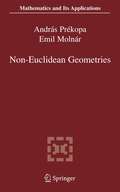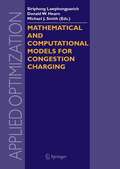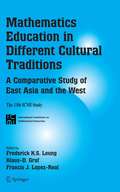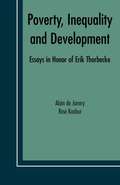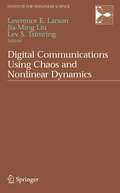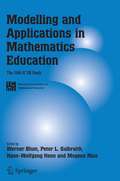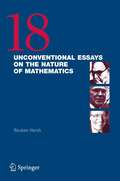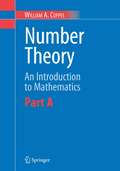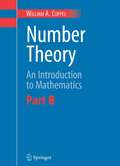- Table View
- List View
Nonparametric Monte Carlo Tests and Their Applications (Lecture Notes in Statistics #182)
by Li-Xing ZhuA fundamental issue in statistical analysis is testing the fit of a particular probability model to a set of observed data. Monte Carlo approximation to the null distribution of the test provides a convenient and powerful means of testing model fit. Nonparametric Monte Carlo Tests and Their Applications proposes a new Monte Carlo-based methodology to construct this type of approximation when the model is semistructured. When there are no nuisance parameters to be estimated, the nonparametric Monte Carlo test can exactly maintain the significance level, and when nuisance parameters exist, this method can allow the test to asymptotically maintain the level. The author addresses both applied and theoretical aspects of nonparametric Monte Carlo tests. The new methodology has been used for model checking in many fields of statistics, such as multivariate distribution theory, parametric and semiparametric regression models, multivariate regression models, varying-coefficient models with longitudinal data, heteroscedasticity, and homogeneity of covariance matrices. This book will be of interest to both practitioners and researchers investigating goodness-of-fit tests and resampling approximations. Every chapter of the book includes algorithms, simulations, and theoretical deductions. The prerequisites for a full appreciation of the book are a modest knowledge of mathematical statistics and limit theorems in probability/empirical process theory. The less mathematically sophisticated reader will find Chapters 1, 2 and 6 to be a comprehensible introduction on how and where the new method can apply and the rest of the book to be a valuable reference for Monte Carlo test approximation and goodness-of-fit tests. Lixing Zhu is Associate Professor of Statistics at the University of Hong Kong. He is a winner of the Humboldt Research Award at Alexander-von Humboldt Foundation of Germany and an elected Fellow of the Institute of Mathematical Statistics. From the reviews: "These lecture notes discuss several topics in goodness-of-fit testing, a classical area in statistical analysis. … The mathematical part contains detailed proofs of the theoretical results. Simulation studies illustrate the quality of the Monte Carlo approximation. … this book constitutes a recommendable contribution to an active area of current research." Winfried Stute for Mathematical Reviews, Issue 2006 "...Overall, this is an interesting book, which gives a nice introduction to this new and specific field of resampling methods." Dongsheng Tu for Biometrics, September 2006
Linear Models for Optimal Test Design (Statistics for Social and Behavioral Sciences)
by Wim J. van der LindenWim van der Linden was just given a lifetime achievement award by the National Council on Measurement in Education. There is no one more prominent in the area of educational testing. There are hundreds of computer-based credentialing exams in areas such as accounting, real estate, nursing, and securities, as well as the well-known admissions exams for college, graduate school, medical school, and law school - there is great need on the theory of testing. This book presents the statistical theory and practice behind constructing good tests e.g., how is the first test item selected, how are the next items selected, and when do you have enough items.
Space, Structure and Randomness: Contributions in Honor of Georges Matheron in the Fields of Geostatistics, Random Sets and Mathematical Morphology (Lecture Notes in Statistics #183)
by Michel Bilodeau Fernand Meyer Michel SchmittSpace, structure, and randomness: these are the three key concepts underlying Georges Matheron’s scientific work. He first encountered them at the beginning of his career when working as a mining engineer, and then they resurfaced in fields ranging from meteorology to microscopy. What could these radically different types of applications possibly have in common? First, in each one only a single realisation of the phenomenon is available for study, but its features repeat themselves in space; second, the sampling pattern is rarely regular, and finally there are problems of change of scale. This volume is divided in three sections on random sets, geostatistics and mathematical morphology. They reflect his professional interests and his search for underlying unity. Some readers may be surprised to find theoretical chapters mixed with applied ones. We have done this deliberately. GM always considered that the distinction between the theory and practice was purely academic. When GM tackled practical problems, he used his skill as a physicist to extract the salient features and to select variables which could be measured meaningfully and whose values could be estimated from the available data. Then he used his outstanding ability as a mathematician to solve the problems neatly and efficiently. It was his capacity to combine a physicist’s intuition with a mathematician’s analytical skills that allowed him to produce new and innovative solutions to difficult problems. The book should appeal to graduate students and researchers working in mathematics, probability, statistics, physics, spatial data analysis, and image analysis. In addition it will be of interest to those who enjoy discovering links between scientific disciplines that seem unrelated at first glance. In writing the book the contributors have tried to put GM’s ideas into perspective. During his working life, GM was a genuinely creative scientist. He developed innovative concepts whose usefulness goes far beyond the confines of the discipline for which they were originally designed. This is why his work remains as pertinent today as it was when it was first written.
Introduction to Data Envelopment Analysis and Its Uses: With DEA-Solver Software and References
by William W. Cooper Lawrence M. Seiford Kaoru ToneIntroduction to Data Envelopment Analysis and Its Uses: With DEA-Solver Software and References has been carefully designed by the authors to provide a systematic introduction to DEA and its uses as a multifaceted tool for evaluating problems in a variety of contexts. The authors have been involved in DEA's development from the beginning. William Cooper (with Abraham Charnes and Edwardo Rhodes) is a founder of DEA. Lawrence Seiford and Kaoru Tone have been actively involved as researchers and practitioners from its earliest beginnings. All have been deeply involved in uses of DEA in practical applications as well as in the development of its basic theory and methodologies. The result is a textbook grounded in authority, experience and substance.
Measurement Errors and Uncertainties: Theory and Practice
by Semyon G. RabinovichA practical reference on theory and methods of estimating measurement errors and uncertainty for both scientists and engineers in industry and experimental research. Building on the fundamentals of measurement theory, this book offers a wealth of practial recommendations and procedures. It differs from the majority of books in that it balances coverage of probabilistic methods with detailed information on the characterization, calibration, standardization and limitations of measuring instruments, with specific examples from both electrical and mechanical systems. In addition to a general updating to reflect current research, new material in this edition includes increased coverage of indirect measurements, with a new, simpler, more efficient method for this class of measurements.
Survival Analysis: A Self-Learning Text (Statistics for Biology and Health)
by David G. Kleinbaum Mitchel KleinAn excellent introduction for all those coming to the subject for the first time. New material has been added to the second edition and the original six chapters have been modified. The previous edition sold 9500 copies world wide since its release in 1996. Based on numerous courses given by the author to students and researchers in the health sciences and is written with such readers in mind. Provides a "user-friendly" layout and includes numerous illustrations and exercises. Written in such a way so as to enable readers learn directly without the assistance of a classroom instructor. Throughout, there is an emphasis on presenting each new topic backed by real examples of a survival analysis investigation, followed up with thorough analyses of real data sets.
Nonsmooth Mechanics and Analysis: Theoretical and Numerical Advances (Advances in Mechanics and Mathematics #12)
by Pierre Alart Olivier Maisonneuve R. Tyrrell RockafellarCompendium of Theoretical Physics
by Armin Wachter Henning HoeberThe Compendium of Theoretical Physics contains the canonical curriculum of theoretical physics. From classical mechanics over electrodynamics, quantum mechanics and statistical physics/thermodynamics, all topics are treated axiomatic-deductively and confimed by exercises, solutions and short summaries.
Soliton Management in Periodic Systems
by Boris A. MalomedDuring the past ten years, there has been intensive development in theoretical and experimental research of solitons in periodic media. This book provides a unique and informative account of the state-of-the-art in the field. The volume opens with a review of the existence of robust solitary pulses in systems built as a periodic concatenation of very different elements. Among the most famous examples of this type of systems are the dispersion management in fiber-optic telecommunication links, and (more recently) photonic crystals. A number of other systems belonging to the same broad class of spatially periodic strongly inhomogeneous media (such as the split-step and tandem models) have recently been identified in nonlinear optics, and transmission of solitary pulses in them was investigated in detail. Similar soliton dynamics occurs in temporal-domain counterparts of such systems, where they are subject to strong time-periodic modulation (for instance, the Feshbach-resonance management in Bose-Einstein condensates). Basis results obtained for all these systems are reviewed in the book. This timely work will serve as a useful resource for the soliton community.
Markov Chains: Models, Algorithms and Applications (International Series in Operations Research & Management Science #83)
by Wai-Ki Ching Michael K. NgMarkov chains are a particularly powerful and widely used tool for analyzing a variety of stochastic (probabilistic) systems over time. This monograph will present a series of Markov models, starting from the basic models and then building up to higher-order models. Included in the higher-order discussions are multivariate models, higher-order multivariate models, and higher-order hidden models. In each case, the focus is on the important kinds of applications that can be made with the class of models being considered in the current chapter. Special attention is given to numerical algorithms that can efficiently solve the models. Therefore, Markov Chains: Models, Algorithms and Applications outlines recent developments of Markov chain models for modeling queueing sequences, Internet, re-manufacturing systems, reverse logistics, inventory systems, bio-informatics, DNA sequences, genetic networks, data mining, and many other practical systems.
Bioinformatics and Computational Biology Solutions Using R and Bioconductor (Statistics for Biology and Health)
by Robert Gentleman Vincent Carey Wolfgang Huber Rafael Irizarry Sandrine DudoitFull four-color book. Some of the editors created the Bioconductor project and Robert Gentleman is one of the two originators of R. All methods are illustrated with publicly available data, and a major section of the book is devoted to fully worked case studies. Code underlying all of the computations that are shown is made available on a companion website, and readers can reproduce every number, figure, and table on their own computers.
Probability and Partial Differential Equations in Modern Applied Mathematics (The IMA Volumes in Mathematics and its Applications #140)
by Edward C. Waymire"Probability and Partial Differential Equations in Modern Applied Mathematics" is devoted to the role of probabilistic methods in modern applied mathematics from the perspectives of both a tool for analysis and as a tool in modeling. There is a recognition in the applied mathematics research community that stochastic methods are playing an increasingly prominent role in the formulation and analysis of diverse problems of contemporary interest in the sciences and engineering. A probabilistic representation of solutions to partial differential equations that arise as deterministic models allows one to exploit the power of stochastic calculus and probabilistic limit theory in the analysis of deterministic problems, as well as to offer new perspectives on the phenomena for modeling purposes. There is also a growing appreciation of the role for the inclusion of stochastic effects in the modeling of complex systems. This has led to interesting new mathematical problems at the interface of probability, dynamical systems, numerical analysis, and partial differential equations. This volume will be useful to researchers and graduate students interested in probabilistic methods, dynamical systems approaches and numerical analysis for mathematical modeling in the sciences and engineering.
Riemannian Geometry (Graduate Texts in Mathematics #171)
by Peter PetersenThis volume introduces techniques and theorems of Riemannian geometry, and opens the way to advanced topics. The text combines the geometric parts of Riemannian geometry with analytic aspects of the theory, and reviews recent research. The updated second edition includes a new coordinate-free formula that is easily remembered (the Koszul formula in disguise); an expanded number of coordinate calculations of connection and curvature; general fomulas for curvature on Lie Groups and submersions; variational calculus integrated into the text, allowing for an early treatment of the Sphere theorem using a forgotten proof by Berger; recent results regarding manifolds with positive curvature.
Bioinformatics of Genome Regulation and Structure II
by Nikolay Kolchanov Luciano Milanesi Ralf HofestaedtThe last 15 years in development of biology were marked with accumulation of unprecedentedly huge arrays of experimental data. The information was amassed with exclusively high rates due to the advent of highly efficient experimental technologies that provided for high throughput genomic sequencing; of functional genomics technologies allowing investigation of expression dynamics of large groups of genes using expression DNA chips; of proteomics methods giving the possibility to analyze protein compositions of cells, tissues, and organs, assess the dynamics of the cell proteome, and reconstruct the networks of protein-protein interactions; and of metabolomics, in particular, high resolution mass spectrometry study of cell metabolites, and distribution of metabolic fluxes in the cells with a concurrent investigation of the dynamics of thousands metabolites in an individual cell. Analysis, comprehension, and use of the tremendous volumes of experimental data reflecting the intricate processes underlying the functioning of molecular genetic systems are unfeasible in principle without the systems approach and involvement of the state-of-the-art information and computer technologies and efficient mathematical methods for data analysis and simulation of biological systems and processes. The need in solving these problems initiated the birth of a new science— postgenomic bioinformatics or systems biology in silico.
Applied Semi-Markov Processes
by Jacques Janssen Raimondo MancaAims to give to the reader the tools necessary to apply semi-Markov processes in real-life problems. The book is self-contained and, starting from a low level of probability concepts, gradually brings the reader to a deep knowledge of semi-Markov processes. Presents homogeneous and non-homogeneous semi-Markov processes, as well as Markov and semi-Markov rewards processes. The concepts are fundamental for many applications, but they are not as thoroughly presented in other books on the subject as they are here.
Multiscale Optimization Methods and Applications (Nonconvex Optimization and Its Applications #82)
by William W. Hager Shu-Jen Huang Panos M. Pardalos Oleg A. ProkopyevAs optimization researchers tackle larger and larger problems, scale interactions play an increasingly important role. One general strategy for dealing with a large or difficult problem is to partition it into smaller ones, which are hopefully much easier to solve, and then work backwards towards the solution of original problem, using a solution from a previous level as a starting guess at the next level. This volume contains 22 chapters highlighting some recent research. The topics of the chapters selected for this volume are focused on the development of new solution methodologies, including general multilevel solution techniques, for tackling difficult, large-scale optimization problems that arise in science and industry. Applications presented in the book include but are not limited to the circuit placement problem in VLSI design, a wireless sensor location problem, optimal dosages in the treatment of cancer by radiation therapy, and facility location.
Non-Euclidean Geometries: János Bolyai Memorial Volume (Mathematics and Its Applications #581)
by András Prékopa Emil Molnár"From nothing I have created a new different world," wrote János Bolyai to his father, Wolgang Bolyai, on November 3, 1823, to let him know his discovery of non-Euclidean geometry, as we call it today. The results of Bolyai and the co-discoverer, the Russian Lobachevskii, changed the course of mathematics, opened the way for modern physical theories of the twentieth century, and had an impact on the history of human culture. The papers in this volume, which commemorates the 200th anniversary of the birth of János Bolyai, were written by leading scientists of non-Euclidean geometry, its history, and its applications. Some of the papers present new discoveries about the life and works of János Bolyai and the history of non-Euclidean geometry, others deal with geometrical axiomatics; polyhedra; fractals; hyperbolic, Riemannian and discrete geometry; tilings; visualization; and applications in physics.
Mathematical and Computational Models for Congestion Charging (Applied Optimization #101)
by Siriphong Lawphongpanich Donald W. Hearn Michael J. SmithRigorous treatments of issues related to congestion pricing are described in this book. It examines recent advances in areas such as mathematical and computational models for predicting traffic congestion, determining when, where, and how much to levy tolls, and analyzing the impact on transportation systems. The book follows recent schemes judged to be successful in London, Singapore, Norway, as well as a number of projects in the United States.
Mathematics Education in Different Cultural Traditions- A Comparative Study of East Asia and the West: The 13th ICMI Study (New ICMI Study Series #9)
by Klaus-D. Graf Francis J. Lopez-Real Frederick Koon Shing LeungThe idea of the ICMI Study 13 is outlined as follows: Education in any social environment is influenced in many ways by the traditions of these environments. This study brings together leading experts to research and report on mathematics education in a global context. Mathematics education faces a split phenomenon of difference and correspondence. A study attempting a comparison between mathematics education in different traditions will be helpful to understanding this phenomenon.
Poverty, Inequality and Development: Essays in Honor of Erik Thorbecke (Economic Studies in Inequality, Social Exclusion and Well-Being #1)
by Ravi Kanbur Alain De JanvryThis collection of essays honors a remarkable man and his work. Erik Thorbecke has made significant contributions to the microeconomic and the macroeconomic analysis of poverty, inequality and development, ranging from theory to empirics and policy. The essays in this volume display the same range. As a collection they make the fundamental point that deep understanding of these phenomena requires both the micro and the macro perspectives together, utilizing the strengths of each but also the special insights that come when the two are linked together. After an overview section which contains the introductory chapter and a chapter examining the historical roots of Erik Thorbecke's motivations, the essays in this volume are grouped into four parts, each part identifying a major strand of Erik's work—Measurement of Poverty and Inequality, Micro Behavior and Market Failure, SAMs and CGEs, and Institutions and Development. The range of topics covered in the essays, written by leading authorities in their own areas, highlight the extraordinary depth and breadth of Erik Thorbecke's influence in research and policy on poverty, inequality and development. Acknowledgements These papers were presented at a conference in honor of Erik Thorbecke held at Cornell University on October 10-11, 2003. The conference was supported by the funds of the H. E. Babcock Chair in Food, Nutrition and Public Policy, and the T. H. Lee Chair in World Affairs at Cornell University.
Digital Communications Using Chaos and Nonlinear Dynamics (Institute for Nonlinear Science)
by Lev S. Tsimring Jia-Ming LiuThis book provides a summary of the research conducted at UCLA, Stanford University, and UCSD over the last ?ve years in the area of nonlinear dyn- ics and chaos as applied to digital communications. At ?rst blush, the term “chaotic communications” seems like an oxymoron; how could something as precise and deterministic as digital communications be chaotic? But as this book will demonstrate, the application of chaos and nonlinear dynamicstocommunicationsprovidesmanypromisingnewdirectionsinareas of coding, nonlinear optical communications, and ultra-wideband commu- cations. The eleven chapters of the book summarize many of the promising new approaches that have been developed, and point the way to new research directions in this ?eld. Digital communications techniques have been continuously developed and re?ned for the past ?fty years to the point where today they form the heart of a multi-hundred billion dollar per year industry employing hundreds of thousands of people on a worldwide basis. There is a continuing need for transmission and reception of digital signals at higher and higher data rates. There are a variety of physical limits that place an upper limit on these data rates, and so the question naturally arises: are there alternative communi- tion techniques that can overcome some of these limitations? Most digital communications today is carried out using electronic devices that are essentially “linear,” and linear system theory has been used to c- tinually re?ne their performance. In many cases, inherently nonlinear devices are linearized in order to achieve a certain level of linear system performance.
Modelling and Applications in Mathematics Education: The 14th ICMI Study (New ICMI Study Series #10)
by Hans-Wolfgang Henn Mogens Niss Peter L. GalbraithThe book aims at showing the state-of-the-art in the field of modeling and applications in mathematics education. This is the first volume to do this. The book deals with the question of how key competencies of applications and modeling at the heart of mathematical literacy may be developed; with the roles that applications and modeling may play in mathematics teaching, making mathematics more relevant for students.
18 Unconventional Essays on the Nature of Mathematics
by Reuben HershCollection of the most interesting recent writings on the philosophy of mathematics written by highly respected researchers from philosophy, mathematics, physics, and chemistry Interdisciplinary book that will be useful in several fields—with a cross-disciplinary subject area, and contributions from researchers of various disciplines
Number Theory: An Introduction to Mathematics: Part A
by W.A. CoppelThis two-volume book is a modern introduction to the theory of numbers, emphasizing its connections with other branches of mathematics. Part A is accessible to first-year undergraduates and deals with elementary number theory. Part B is more advanced and gives the reader an idea of the scope of mathematics today. The connecting theme is the theory of numbers. By exploring its many connections with other branches a broad picture is obtained. The book contains a treasury of proofs, several of which are gems seldom seen in number theory books.
Number Theory: An Introduction to Mathematics: Part B
by W.A. CoppelThis two-volume book is a modern introduction to the theory of numbers, emphasizing its connections with other branches of mathematics. Part A is accessible to first-year undergraduates and deals with elementary number theory. Part B is more advanced and gives the reader an idea of the scope of mathematics today. The connecting theme is the theory of numbers. By exploring its many connections with other branches a broad picture is obtained. The book contains a treasury of proofs, several of which are gems seldom seen in number theory books.
